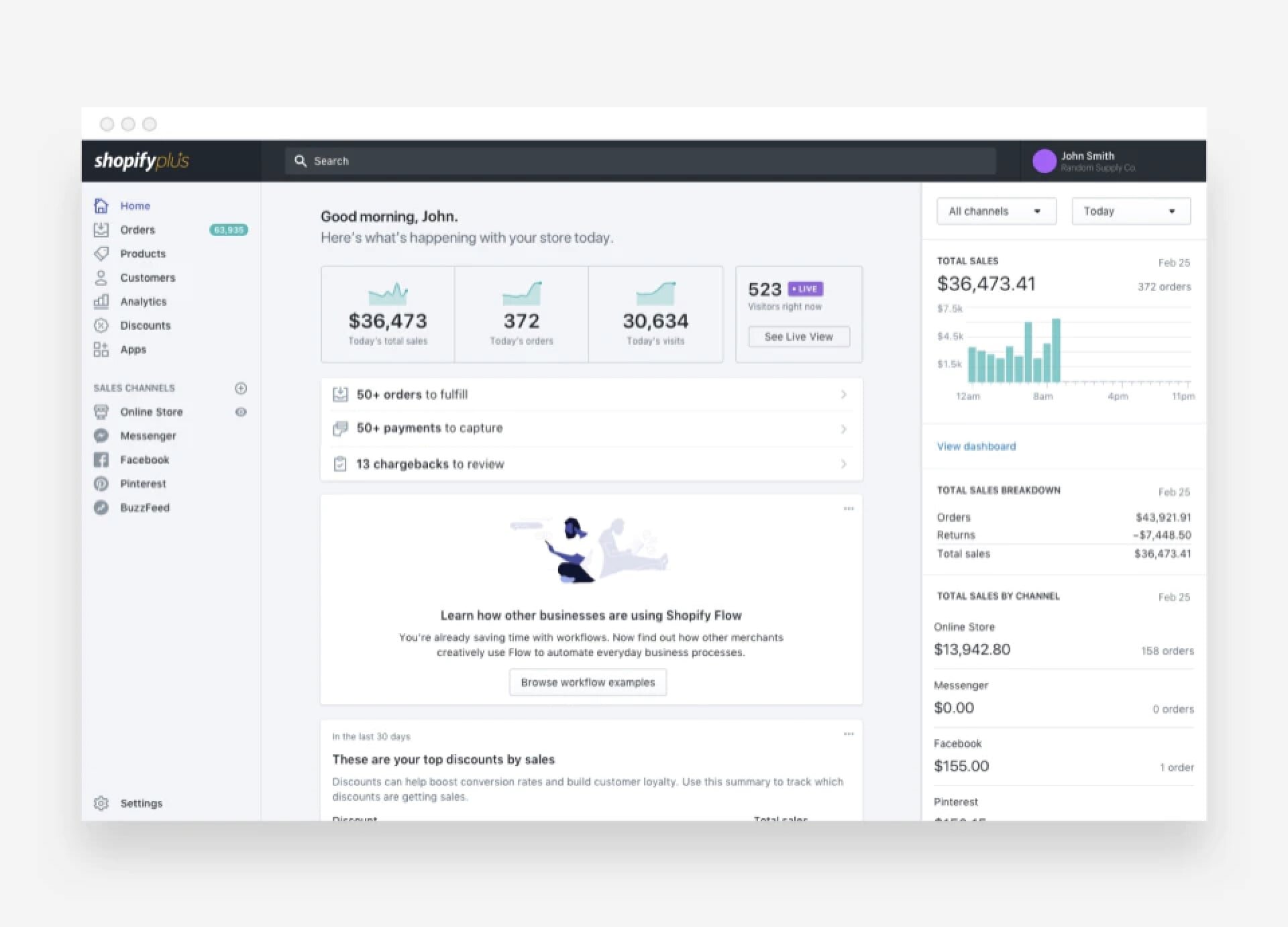Creating eCommerce success: Magento Commerce 2 or Shopify Plus?
As the world of eCommerce continues to evolve, making online shopping the dominating factor for all a majority of modern-day retailers, ensuring your brand is making use of the best possible platform is half the challenge. Digital marketing techniques and advertising opportunities are giving companies of all kinds, the chance to be seen across the digital landscape even more than before, but finding a place to call home is the make or break.
Two key players in combating this minefield are Shopify Plus and Magento Commerce 2, raising the benchmark for what it means to utilise highly intuitive eCommerce solutions.
For businesses sitting on the mid-market level or even extending out to be high-end enterprises, both of these platforms give plenty of brand-enhancing features. So, in this article, we're covering all the key differences you need to make a note of (and doing it transparently), so you can choose between the two to power up your eCommerce game.
But first, a little disclosure
It should be pointed out that neither of these platforms actually “beat” each other, per se. They both have their own distinct advantages and disadvantages. You just need to weigh them up in terms of your own business objectives and the gaps you need to fill – like any software-related decision.
Ultimately, one of the biggest driving factors should be to sit down and think about how complex your business’s operating nature is. If your developmental and inventory requirements aren’t as straight-forward as most, this needs to be kept as a high priority, and will significantly impact your decision.
As you read through the rest of this article, remind yourself of this question and correlate it back to the features we explain for each solution: do they meet your specific needs?
Hold up: Are you thinking of migrating your website over to Shopify or Magento? We can help. We recommend locking in a no-obligation discussion with our experts to see how we can kick start this process without the hurdles or hassle.
Breaking it down: the difference between Shopify Plus and Magento Commerce 2
Okay, we’ve kept you waiting long enough, so let’s get down to it. We’ve listed the most notable differences between Shopify Plus and Magento Commerce 2 below, giving you a quick run-down of the primary features.
SHOPIFY PLUS KEY FEATURES
Hosting: Fully hosted
Support: 24/7 customer support and account management.
Development access: Limited back-end development access and only a small amount of front-end development support.
Customisation: Not as flexible with customisation as Magento.
Products: Packages support two product types.
Product variations: 100 maximum.
Cost: $2,000/month plus 0.25% of average revenue once your store reaches $800,000 in revenue. This caps at $40,000/month.
Ideal for: Large-scale enterprises going through significant growth. Businesses who require less access to development features.
MAGENTO COMMERCE 2 KEY FEATURES
Hosting: Hosted on an external server with the option of Magento Commerce Cloud.
Support: Choose between open-source packages with no management; or general support through a paid license.
Development access: Expect plenty of developmental work.
Customisation: Extremely customisable, in comparison to Shopify Plus.
Products: Packages support seven product types. Digital and downloadable products are also supported.
Product variations: Almost unlimited.
Cost: Annual fee that depends on gross merchandise volume. Approximately $22,000/year.
Ideal for: Large-scale enterprises that have extensive product portfolios. Also highly suitable for international labels.
The buzz about Shopify Plus
In a lot of ways, Shopify Plus is designed to suit enterprises, but it’s also highly suitable for businesses that are looking to expand their offering. If growth and scalability are high on your list of priorities, this platform takes the journey from A to B with you.
Initially, the platform serviced smaller brands only, but after years of success in the field, it’s grown to offer an extensive suite of solutions for hands-on, large-scale enterprises. The result is a nifty piece of software that’s specifically tailored to go from initial growth stages to an all-out high-volume business – given the Shopify team itself have gone through the same adventure.
So what’s the big deal of opting for Plus over standard Shopify packages?
Advanced features, apps and customisation: If you like to remain in control of your checkout, Shopify Plus gives more responsive options than the standard solution. There are also lots of add-ons, like integrations and customisations, that allow for more intuitive customer experience. Did we mention endless apps?
Comprehensive support: For those that prefer the peace of mind of having a team by your side that’s dedicated to customer support, Plus is nifty to have. You receive your own allocated account manager, as well as launch managers – if you require these options.
Flat-fee pricing: The cost structure is simple at $2,000 a month if you turn over less than $9.6 million in annual sales.
The low-down on Magento Commerce 2
Somewhere along the line, you may have heard this platform referred to as Magento Enterprise, and that's still mostly what it is today.
Back in 2018, Adobe acquired the software, extending its offering out to suit larger businesses with a variety of complex needs. With open-source capabilities and a huge community of developers on hand, the detailed nature of this platform outweighs Shopify in this respect.
But if you don’t need all the bells and whistles, then this aspect is neither here nor there. With this in mind, if you’re a business that is growing but can’t support the need for hands-on developmental work, then Magento Commerce 2 isn’t the best choice here.
Magento is largely designed to equip businesses that need plenty of control over their developmental elements with the ability to do so. What you lose out on, however, is price-efficiency, a more demanding platform and the need to allocate more of your resources to get the most out of it.
Which is easier to use?
We're all about user-friendliness, experience and comprehensive support. Both of these platforms have their own pros and cons for these criteria. Where one excels, the other doesn't – so keep these in mind as you progress through the decision-making process.
Using Shopify Plus
On a basic level, Shopify is super user-friendly. If you’ve never run an online store or eCommerce brand before – even a website – the platform is designed to embrace this skill level. If you’re an expert or Jack-of-all-trades, it’s still highly suitable.
However, if you need further integrations to give more advanced functionalities, Plus is definitely required. This provides access to API integrations, theme code access, the latest apps and analytics reports (which we highly recommend).
Here's the short straw, though. If you are a developer or have a development team standing by to take control, then Shopify Plus is where the door closes. There's limited access for these features, so it's safe to say it's simply not designed for a hands-on
Using Magento Commerce 2
For developers who love to dive into a world of customisation, Magento Commerce 2 is the heaven you've been waiting for. You need experience under your belt to tackle this platform efficiently and effectively, but it is well worth it.
Enjoy the ability to fully customise the features to suit your business and adjust them as you scale wholeheartedly. The only sacrifice is, once again, you do need a dedicated team of resources to handle the level of development required.
Making a decision
When you're ready to sit down and make the final call, the above notes are a well-rounded guide to get you started. However, we want to remind you of the initial question over your business’s needs and the gaps that need filling.
If you are a large brand that grows exceptionally quickly, is agile and equipped with a resource-driven development team, Magento Commerce 2 is your pick of the bunch.
However, if you're after a solution that gives customer support when it's needed, smooth user experience and not having to worry about development, Shopify Plus is your new sidekick.
If you're planning on making a move from your current eCommerce platform to Shopify or Magento, we recommend getting in touch with our digital marketing experts now. We can help you assess which solution is the best choice for you, and iron out any complexities that may be involved.




